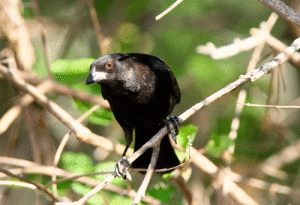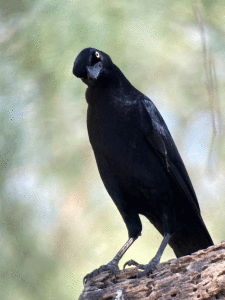
A male Bronzed Cowbird checking out its habitat. By Mike Williams
The blackbirds. Most of us see them daily, all black, often noisy, and gregarious. We know that there are small ones and large ones, but that’s about as much we pay attention to them. But there is a world of difference between these different species, and some neat behaviors that we can learn about. There are many species from two very distinct groups of birds that make up the blackbird clans.
The largest of these birds belong to the corvid group which includes jays, crows, and ravens. We normally only see one corvid species along our immediate gulf coast, the American Crow, the bully of the bird world some say. They are big, and noisy, but they are arguably one of the smartest birds out there.
American Crows inhabit many of our habitats, including our more suburban areas. They live near the coast in tree lines near the coastal marshland, in the bottomland hardwood forests, open farmland, as well as our backyards. They seldom visit the beach fronts. They scavenge and steal, as well as forage for their food. Their diet is made up of a myriad of foods, including earthworms, insects and other small animals, seeds, and fruit but also garbage, carrion, and chicks they rob from nests. They are masters at survival.
American Crows are very social birds and can form large flocks sometimes in the thousands. They are also very inquisitive, somewhat mischievous, and very quick learners that can solve problems. They defend what’s theirs aggressively, and don’t fear chasing away larger birds, including birds of prey such as hawks and owls.
Then there are the black birds that belong to the icterid group. This is a rather diverse group of birds, including blackbirds, cowbirds, grackles, bobolinks, meadowlarks, and even the colorful orioles. The most noticeable of the icterid black birds are the Great-tailed Grackles. They are not as large as crows but often mistaken for them. The males are a dark shiny black, often with blue and green sheen to their feathers. Females have more subdued blacks and browns.
Their cousins, the Boat-tailed Grackles, are very similar but sound a bit different and have dark eyes instead of yellow. Boat-tales are only found along the immediate coast and marshes, and not inland. Great-tailed can be found everywhere. The Common Grackle is their smaller cousin, which only resides here during the winter months, often in large flocks. They look similar are but about two thirds the size.
To round out this group are the smallest of this bunch. There’s the Red-winged Blackbirds with their bright red patch on their upper wing, the aptly named Brown-headed Cowbird with their dull brown heads, and the less common Bronzed Cowbird with their hunchbacked appearance and bright red eye. Both cowbird species are considered parasites as they use the nests of other bird species to lay their eggs in and often let those other birds raise their young. This was not a problem in the past when they naturally followed the roaming buffalo herds, but as buffalo were replaced with stationary cows, cowbirds no longer roam vast areas but affect the same area birds over and over. This has led to a reduction in songbird populations, and since this was a man-made problem, in some areas cowbirds are being manually controlled to save rare or endangered species.
No matter what people feel about this group of birds, the fact remains that they are smart, resourceful, and highly entraining to watch. I love watching them out the window from my office here at the Gulf Coast Bird Observatory!

A male Great-tailed Grackle isn’t quite approving of the situation!
By Martin Hagne
